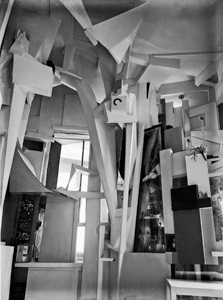KURT SCHWITTERS (1887, 1948)
German Artist, Poet, Playwirght



Horst gave us very few definitive statements qbout his work. But he did describe his collages as "A combination of Astract Expressionism and Kurt Schwitters". Not only is this accurate, but it gives us insight how important Schwitters was to Horst. This statement likely coincided with the 1961-2 "The Art of Assemblage" exhibit in New York, Dallas and San Francisco, which included 35 of Schwitters' works. Such a prominent exhibit would have made Horst's reference recognizable to Bay Area art aficionados. It alos gave Horst instant German Dadaist cred.
Schwitters was an astonishingly innovative and wide ranging artist, freely mixing collage, Dada, performance art, installations, found objects with poetry, theater, political and social commentary. He seems more like an artist from 2020 rather than 1920. Schwitters' lesson for young art students was to follow your personal vision to its end, regardless of the consequences; stop at nothing.
"I'm a painter, and I nail my pictures together."
-- Kurt Schwitters, 1918
Dada was founded in the middle of WW-I as an antidote to its horrors. Schwitters was first exposed to Dada in Berlin through Hanna Hoch, Richard Huelsenbeck, and Raoul Hausmann. But Schwitters eventually founded his own version of Dada which he called Merz, a name believed to be taken from Commerz Bank, a sarcastic comment on commercialism. The collage above in the middle is called Merz Bild #20.
A seminal work of Merz was his Merzbau, a house that is also a work of art made from thousands of found objects. You can see a photo of a small part of the Merzbau above right. Its design is more radical than anything you can find today.
The Merzbau is a little like Georgia O'Keefe's Abiquiu and Horst's Fairfax garden. Some artists are compelled to transform their environment into a work of art, in a kind of overflow of artistic energy.
Because Schwitters was a German gentile and among the most overtly modern, he became the a special target of the Nazis. They made a crusade of eradicating all 'degenerate' art from Germany, destroyed tens of thousands of works and forced the their best artists out of the country. Klee to Switzerland, Kandinsky to Paris, and in 1933 Schwitters left for England, never to return. Schwitters was born in Hannover, so after the war his work would have been making its way back to local museums. Horst's Art school was nearby and would have embraced Schwitters as a local art hero.
Schwitters was on track to become the most under-appreciated artist of the 20th century, until, the exhibit "The Art of Assemblage" brought him to the United States. His influence on the nascent Neo-Dada and Pop-Art movements cannot be underestimated. This show had a huge impact on these artists, not to mention Schwitters' reputation. Today Schwitters is recognized as one of the greatest artists of the 20th century.